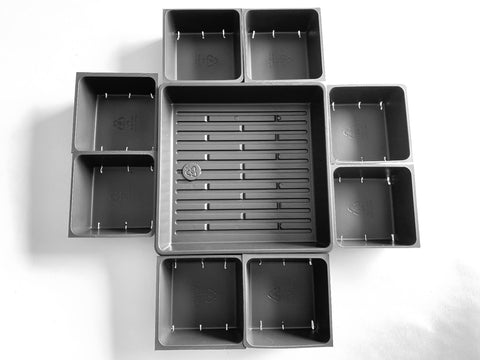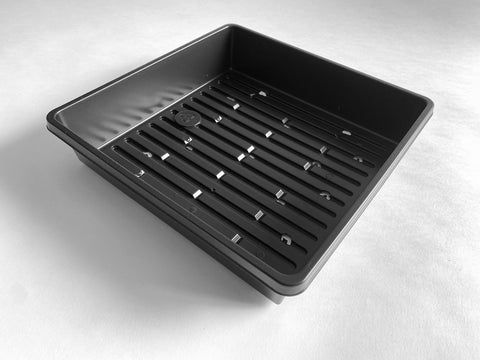

Long Life Micro-Greens
Broccoli, Red & Green Cabbage, Purple Kohlrabi, Collard Greens, Green Kale, Red Russian Kale, 3-4 varieties of Radish, Turnip, Oriental Mustard, Arugula, Curly Cress, Mizuna & Tatsoi.
Many Brassicas come together beautifully in a symbiotic blend of delicious nutrition! Research has shown that antioxidant content can increase when certain sprouts grow together. We base our mixes on taste, texture and growth rate for the most part, but we considered "science" too, when we made this mix up.
These same seeds grow Nutritiously Delicious Sprouts too. Note: We sell Long Life Mix by the 1/2 pound.
Vitamins A, B, C, E and K
Calcium, Iron, Magnesium, Phosphorus, Potassium, Zinc
Carotene, Chlorophyll, Amino Acids, Trace Elements
Antioxidants
Protein: 30-35%
Very tender. From sweet to spicy and perfect all together.
The time it takes to grow a finished 7 - 14 days, or other crop (Micro-Greens, Grass, Greens) from a dry Seed. Note: This "finished" Sprout is our preference. you may grow them for as long as you want! In fact, we suggest that you taste them at every rinse to discover when you like them best.
How to Grow Long Life Micro-Greens
- Plant 1-2 teaspoons of seed (for a 5x5 inch Tray) on thoroughly moistened medium.
- Cover your crop with another tray, or a plate - to keep light out and moisture in.
- Keep your medium moist by watering lightly as needed. Don't drench!
Use Coconut Coir and you likely won't have to water at all after planting! - When your plants have begun to show leaves, remove cover and move your crop to a well lit location.
- Harvest when the leaves are open and an inch or three tall (day 5-14).
- Cut just above the medium, with a scissors or sharp knife.

8 wonderful Brassicas planted atop the perfect Medium: 60% Coconut Coir, 20% Earthworm Castings, and 20% Vermiculite.
Start by thoroughly moistening the medium. Thoroughly moist means saturated but not dripping. Proceed by spreading your seed evenly (don't sweat this - just do your best) across the medium. Cover with whatever makes sense. It depends on what you're growing in.
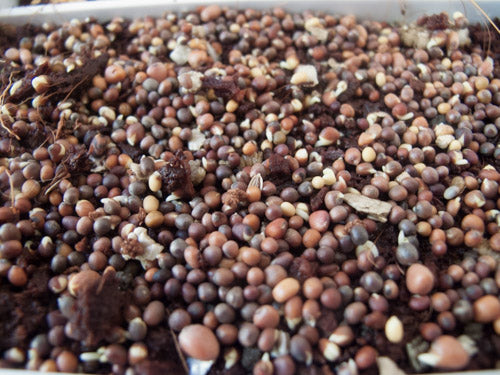
12 hours later...
If we look closely we are already seeing germination
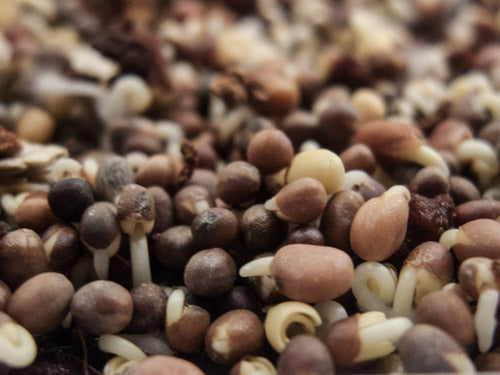
12 hours later...
This closer view shows that here is now a lot of germination happening.

12 hours later....
The fuzzy stuff you see is Not mold - those are Root Hairs - microscopic roots which grow off the tap (main) root. They are good. They are beautiful. If you have a magnifying glass, take a look. When we see Root Hairs on sprouts they disappear after Rinsing because the water makes them fall back along the tap root. Since we are not watering our Micros they stay visible. If you were to water now they would vanish. Enjoy them.

12 hours later...
Besides those amazing root hairs we can now see leaves. They are yellow, but there are already enough of them to give our Micros light, so uncover your crop and move it to a well lit location.

12 hours later...
Photosynthesis happens!

12 hours later....
Amazing plants full of amazing potential growing amazingly fast.
When I say potential this is what I mean: In nature, each of these seeds would grow into huge plants which would produce thousands of seeds. Each seed produces thousands of seeds! Is it any wonder that these crops are so packed with nutrition?!

Another view of our crop at the same time.
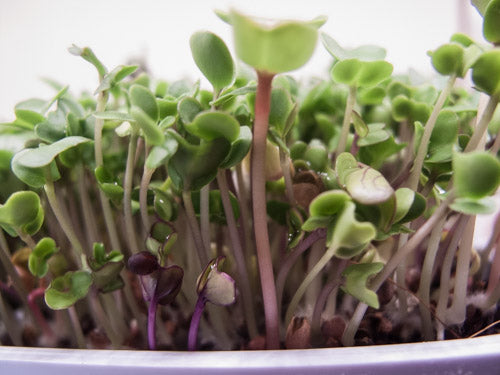
12 hours later....
There are 8 different kinds of seed in here, remember? The big one in front is a Radish. The little purple ones are Red Cabbage. We can now see that some grow faster than others, but that's fine and dandy in this case. Everything is growing wonderfully.

12 hours later....

12 hours later....

12 hours later....

12 hours later....
Harvest now - if you haven't already given in to temptation.
All you need do is cut them near the Medium.

Same time....
The tallest ones are Radishes, but everyone is pretty tall now.

8 wonderful Brassicas planted atop the perfect Medium: 60% Coconut Coir, 20% Earthworm Castings, and 20% Vermiculite.
Start by thoroughly moistening the medium. Thoroughly moist means saturated but not dripping. Proceed by spreading your seed evenly (don't sweat this - just do your best) across the medium. Cover with whatever makes sense. It depends on what you're growing in.

12 hours later...
If we look closely we are already seeing germination

12 hours later...
This closer view shows that here is now a lot of germination happening.

12 hours later....
The fuzzy stuff you see is Not mold - those are Root Hairs - microscopic roots which grow off the tap (main) root. They are good. They are beautiful. If you have a magnifying glass, take a look. When we see Root Hairs on sprouts they disappear after Rinsing because the water makes them fall back along the tap root. Since we are not watering our Micros they stay visible. If you were to water now they would vanish. Enjoy them.

12 hours later...
Besides those amazing root hairs we can now see leaves. They are yellow, but there are already enough of them to give our Micros light, so uncover your crop and move it to a well lit location.

12 hours later...
Photosynthesis happens!

12 hours later....
Amazing plants full of amazing potential growing amazingly fast.
When I say potential this is what I mean: In nature, each of these seeds would grow into huge plants which would produce thousands of seeds. Each seed produces thousands of seeds! Is it any wonder that these crops are so packed with nutrition?!

Another view of our crop at the same time.

12 hours later....
There are 8 different kinds of seed in here, remember? The big one in front is a Radish. The little purple ones are Red Cabbage. We can now see that some grow faster than others, but that's fine and dandy in this case. Everything is growing wonderfully.

12 hours later....

12 hours later....

12 hours later....

12 hours later....
Harvest now - if you haven't already given in to temptation.
All you need do is cut them near the Medium.

Same time....
The tallest ones are Radishes, but everyone is pretty tall now.
Yields approximately three times as many Micro-Greens (by weight) as seed "planted"
We put quotes around Planted because
the seeds are spread atop a medium - not planted under.
PLEASE read the contents of Notes Tab (to the right)
for variations and a whole lot more information.
Grow these on the ultimate medium -
Coconut Coir, soil, or a soilless medium like
Baby Blanket, in a
Compostable Tray - or for bigger crops you can use a
10x20 Tray, or another of our Growing Trays.
Or - grow them upon a flat Hemp Bag, or in our gorgeous Euro-Sprouter.
I know - too many choices. That's our biggest problem here at Sproutpeople. Choices!
So I'm going to tell you the way I (who has every possible option available) grow Micros.
I always use Coconut Coir!
I mix Earthworm Castings into my Coconut Coir for added nitrogen (which is very good for green plant growth), at a rate of 25%
Castings to 75% Coconut Coir.
I grow in our Compostable Tray if I am going for Cotyledons (the first leaves), or
a 5x5 Nursery Tray if I want True Leaves.
The Nursery Tray is deeper - which gives the roots more room to grow - so the plants can grow bigger more easily.
Thoroughly moisten the Medium upon which you are going to grow.
Measure your seed
For a thick crop of Cotyledon (first leaf) Micro-Greens
plant the larger amount. For bigger, True Leaf Micros plant the smaller amount.
Compostable Tray = 1 tsp. - 2 tsp.
5x5 Nursery Tray = 1 tsp. - 2 tsp.
10x10 Tray = 1 - 2 Tbs.
10x20 Tray = 2 - 4 Tbs.
Hemp Bag = 2 - 4 tsp.
Euro-Sprouter = 1 - 2 tsp.
If you are going for True Leaves you really must use a Growing Tray
that is at least 2 inches deep - like our 5x5, 10x10, or 10x20 inch Nursery Trays.
Spread seeds as evenly as you can - all over your thoroughly moistened Medium.
Cover your crop: If you're planting in a 5x5 Tray use another identical tray - up side down. Same thing with other Trays. If using a Compostable Tray snap the clear lid on for the first 2-3 days. If using a Hemp Bag, or another medium - be creative. If it's on a plate then use an identical plate (upside down) as a cover. For the Euro-Sprouter - use the cover that comes with it. It is not mandatory when growing Micro-Greens to cover them at all. Experiment for yourself and see what works best in your climate/location. I cover.
Place your Micro-Garden in a low-light, room temperature location (70° is optimal).
Once germination occurs - keep the medium moist by watering gently or misting with a Spray Bottle every day or three. The deal with watering is that the deeper your medium, the less you need to water, and the plants won't require a lot of water until they get growing big - at which point you may need to drench the medium every day. When using our Compostable Tray (which has no drainage) you can pour off excess water by tipping it.
Note: These wonderful little Brassica plants have a unique root structure. Brassicas will show microscopic roots starting on day 2 or 3. They are called root hairs and are most visible just before watering - when the plants are at their driest. These root hairs impress many people as mold - but they are not. When you water your crop the root hairs collapse back against the tap root. Viola! No root hairs! Now you know. Isn't learning fun?!
When your plants grow up and begin to shed their hulls they are ready for light so move them (if necessary) to a well lighted location. If you go with sunlight -
water more frequently. Room light will usually do quite nicely - and will not dry out your medium as
quickly. One consideration here - if you are going for True Leaves you should definitely use sunlight in a warm place.
The most beautiful Micro-Greens we have ever seen were grown in a greenhouse in Burlington, Vermont (in summer) by our friends Spencer
and Mara at Half-Pint Farm. Just had to mention that. They taught me and Lori a lot!
Keep the medium moist by watering regularly. Water from the side if possible to prevent injuring the tiny plants.
When your plants have open leaves which are green, they are done - unless you're going for True Leaves, in which case you need to keep watering and tending for another week or more.
Cut the plants just above the medium upon which they have grown. During the final 8-12 hours minimize the surface moisture of your plants - they will store best in your refrigerator if they are dry to the touch. So if you water try to keep the water off the plants - just water the medium.
When you are ready to store them (I'll remind you that these degrade fairly quickly, so eat them instead of storing them if you can), if they are still damp - lay them between some paper towels or anything you prefer, and dry them very gently. Transfer your crop to a plastic bag or the sealed container of your choice - glass is good. We sell an amazing Produce Storage Bag that actually extends the shelf life of produce, if you're interested in the best of the best =;-) Whatever you store them in; put them in your refrigerator - if you must.
Great Job Sprout farmer!
17 Brassicas combine to make another lovely, delicious and of course nutritious Micro-Green mix. In this case you get high levels of antioxidants (We aren't claiming that mind you, but the statement is based on published research) as well as the usual wealth of vitamins, minerals and amino acids found in sprouts and microgreens.
Note: Canadian and US researchers have found that Brassicas contain antioxidants such as sulfurophane. And that a symbiotic relationship exists where combining brassicas increases their total soluble antioxidants. It's a family thing =:-D All of the seeds in Long Life Mix are Brassicas.
All of the seeds are current crop year and amazingly vigorous.
Seed Shelf Life: 5 years. Store in cool, dark, dry spot. Store in freezer to extend shelf life.
Sproutpeople and Micro-Greens
We first grew Micro-Greens back in 1994. We were way ahead of the curve. Nobody was interested in them - not our farmers market customers, not our food stores (co-ops, natural food stores and grocery stores we delivered to every week), not our restaurants, nobody! That did change some as the years passed, but we were always Sprout People first. Frankly, we prefer Sprouts to Micros because we find them plumper and more texturally pleasing - but we keep working with them. Some seeds (especially mucilaginous seeds) won't grow as sprouts and Micro-Greens are SO gorgeous and offer a lot of unique and really cool possibilities.
Soaking and Pre-Sprouting
Though our instructions (in the Growing Instructions Tab - to the left) used to suggest these steps (for non-mucilaginous seeds), we have found
them less and less necessary as we've worked with Micro-Greens.
We skip both now, concentrating first on thoroughly moistening
our medium. We then plant the seeds (which are just spread atop that thoroughly moistened medium), and mist them with a Spray Bottle, when appropriate. We then cover our planted seeds.
We mist them with a Spray Bottle at least once a day until they sprout, and then bury their roots in the medium. During those first 2-3 days we are
misting heavily for some - - not at all for others.
We uncover the crops at different stages, depending on what we are doing with a particular crop. Keep reading to learn more.
Fertilizing Micro-Greens
When growing on a soilless medium like Hemp Felt - it is advisable to use Liquid Kelp Feritlizer
to give your plants
additional nutrients to draw upon. When we use Kelp we dilute 1 tsp. in 1 quart of water (this is a higher concentration than the product label calls for).
We use it in a Spray Bottle or by watering the medium directly. We use it every time we water.
The perfect container for these soilless mediums is our inexpensive Compostable Tray.
If you plant on soil - or better yet with Coconut Coir (our FAVorite), mix in 25% Earthworm Castings
for the ultimate nutrient rich, moisture retaining planting medium. Mix them together thoroughly before moistening.
Micro-Green Variations
There are varying opinions of what constitutes a Micro-Green. Traditionally it is just a plant grown to
the Cotyledon (first leaf) stage, and cut above the medium upon which it is
planted.
When we grow to this stage; we either grow on Hemp Felt, soil (any kind will do) , or our favorite -
Coconut Coir. Hemp Felt is less messy and works fine and dandy. We cut a piece to fit a
plate, then we follow our own instructions for keeping the medium and seeds-sprouts thoroughly moist. We use another of the same size plate
- inverted - as a cover. We uncover our plants when they are about 1/2 inch tall, or when they are hitting the covering plate. We then expose them to
all the light our kitchen has to offer. We even use direct sunlight when available. We have to water them more often when we do this. When it comes
to watering, We mist them with a Spray Bottle until the seeds have firmly rooted. After that - when growing on a piece of
Hemp Felt on a plate; pour water directly onto the plate. We gently tip and turn the plate so as much water as
possible gets soaked up by the Hemp Felt, and then pour off most of the excess.
When growing on soil or
Coconut Coir; we continue
to spray with the Spray Bottle, but we keep the medium moist by adding water directly
to the plate or solid tray it is sitting on/in. We allow the medium to drink up what water it can, and then
gently pour off the excess. Leaving a little water on the plate is fine - it will get sucked up before your next watering. If it doesn't, cut back a bit next time.
There are some nowadays who want a Micro-Green to be a plant which puts out a True Leaf before they'll call it a Micro-Green. We find that concept Very interesting, so we have worked to make that happen.
The first thing is to plant less seed. Just how much is the question. The general rule is this: The more space your plant has to
grow roots - the bigger it can grow.
We are currently using 1/4 teaspoon in a 5x5 inch tray. That leaves quite a bit of room between the seeds-plants, but
gives them enough space to grow to the True Leaf stage. This can take 2 weeks or more. The main
thing that is needed is More Light. Plants get "leggy" when they need to reach for light. We use that to our advantage in all other circumstances in the
Sprout World, but here we want to minimize the legginess of the plants. If you can put a light right above your crop - or keep it in direct sunlight,
that will help. Keep everything adequately moist. Remember - the more light the faster the medium and plants
will dry. This may sound like a lot more work, but really it isn't much more than usual.
We cover the seeds only until they have sprouted when growing this
way. We plant on Coconut Coir (which hold moisture like nothing else we've ever worked with)
enriched with 25% Earthworm Castings, which add nitrogen that a plant uses to grow
leaves. When making up the mix, do not exceed 25% Earthworm Castings as too much nitrogen can burn your plants (they
actually whither and die when the soil is too "hot" - which means it has too much nitrogen). Mix the castings into the base
Coconut Coir, or soil (any kind will work, though
we do not advise mixes that are heavily peat moss as we find it hard to work with and we don't find the crop turns out as well) - it is the roots that will need
access to the rich medium.
If growing a mix, not all of the plants will grow True Leaves at the same
time. Keep growing until most have them. Harvest then and eat them up. Though you can store Micro-Greens,
they degrade quickly, and since you have put so much work in these - you should enjoy them at their peak.
The Next Variation
The next obvious step (to us anyway) we find really exciting. It is to grow even fewer seeds into even fewer plants. Those plants will grow more leaves. They will be more like Baby-Greens than Micro-Greens. They will require more time. They may re-grow more quickly because they'll have a bigger root-mass. The container (tray, pot, etc.) they grow in will likely be too small for that root-mass to live long, but it's possible. When it comes right down to it, we're talking about an indoor-garden. All the other stuff we offer is about indoor gardening, but this is more like a garden. Not many of us have space in our homes to Garden inside, but we love the idea. We're working on this, and we'll tell you what we find out as soon as we know something. It was gardening that eventually led us to sprouting. We feel like this is closing that circle started so long ago - now it is sprouting leading back to gardening @:-) Start with Coconut Coir enriched with Earthworm Castings and you'll have a great experience. Happy Micro-Greening!
Recommended Sprouters for Long Life Micro-Greens
We grow these as sprouts in the Easy Sprouter and as Microgreens in both the Stainless Steel Sprout and Small Stainless Sprouter on the wall in front of the sink. Both crops are totally delicious, but when grown in the SS sprouters, the leaves get much bigger and longer stems. Either way, I no longer buy the individual seeds, but just use the Long Life Mix. A little spicy but we love it. My husbands favorite sprouts and his eyes light up when I bring him a bowl of these microgreens/sprouts. Kudos to Gil and Lori for this combo.
We grow these as sprouts in the Easy Sprouter and as Microgreens in both the Stainless Steel Sprout and Small Stainless Sprouter on the wall in front of the sink. Both crops are totally delicious, but when grown in the SS sprouters, the leaves get much bigger and longer stems. Either way, I no longer buy the individual seeds, but just use the Long Life Mix. A little spicy but we love it. My husbands favorite sprouts and his eyes light up when I bring him a bowl of these microgreens/sprouts. Kudos to Gil and Lori for this combo.
I previously ordered the brassicas separately until I found Long Life and the Stainless Steel sprouter.
This perfect combination of seeds is bursting with flavor with a slight kick of radish. The seeds grow in the SS Sprouters, large and small, the Easy Sprouter and on a medium with consistent bravado . We are in sprout/microgreen heaven. My meat and potatoes husband loves these and has them with as a salad or snack.
I like the combo because it saves me from making my own, 1 quarter teaspoon at a time.
On a medium we get an even more robust crop. Highly recommend. Thank you for creating this combo.
I previously ordered the brassicas separately until I found Long Life and the Stainless Steel sprouter.
This perfect combination of seeds is bursting with flavor with a slight kick of radish. The seeds grow in the SS Sprouters, large and small, the Easy Sprouter and on a medium with consistent bravado . We are in sprout/microgreen heaven. My meat and potatoes husband loves these and has them with as a salad or snack.
I like the combo because it saves me from making my own, 1 quarter teaspoon at a time.
On a medium we get an even more robust crop. Highly recommend. Thank you for creating this combo.


